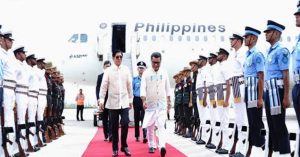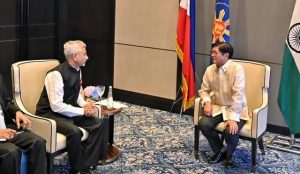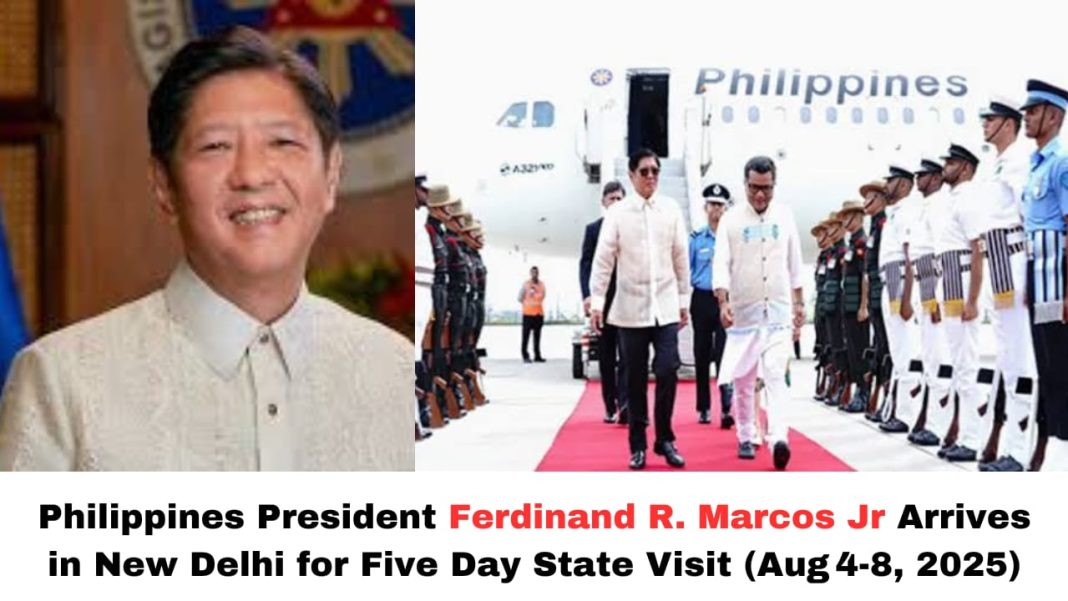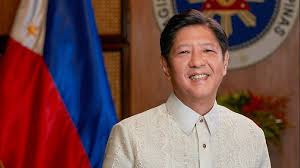Digital News Guru Current Affairs Desk:
Philippines President Marcos Jr Arrives in New Delhi for Landmark State Visit (August 4–8, 2025)
Philippines President Ferdinand R. Marcos Jr., accompanied by First Lady Louise Araneta‑Marcos, senior Cabinet ministers, embassy officials, and a high‑level business delegation, landed at Delhi Indira Gandhi International Airport at 2:20 p.m. IST on August 4, 2025, kicking off his first state visit to India since assuming office in 2022. The visit—scheduled through August 8—commemorates the 75th anniversary of formal diplomatic ties between the two Indo‑Pacific democracies.
Aged Partnership Anchored in Shared Values
India and the Philippines formally established diplomatic relations in November 1949. Over decades, ties have grown across culture, trade, and governance, underpinned by democratic values and maritime security. Current relations are embedded within India’s Act East Policy, Vision MAHASAGAR, and ASEAN cooperation frameworks—key pillars for regional stability in the Indo‑Pacific.

Maritime Security & Defence at the Core
A key focus of this visit is the evolving defence and maritime partnership, particularly amid tensions in the South China Sea. The Philippines became the first export recipient of India’s BrahMos cruise missile system in 2024 under a Rs 3,100 crore ($375 million) deal signed in 2022. Manila is reportedly in negotiations to acquire additional batteries, reinforcing coastal deterrence and interoperability with the Indian Navy.
Joint Naval Sail Signals Rising Maritime Coordination
In a historic display of naval collaboration, Indian and Philippine warships performed their first joint sail inside the Philippines’ Exclusive Economic Zone, commencing August 3, just ahead of the visit. The Indian flotilla included INS Delhi, INS Shakti, and INS Kiltan, while the Philippines deployed its frigates BRP Miguel Malvar and BRP Jose Rizal. Philippine military officials noted that Chinese vessels were seen shadowing the exercise, elevating its geopolitical significance.
During the sail, Philippine Armed Forces Chief Gen. Romeo Brawner Jr. described it as a vital “demonstration of resolve to uphold freedom of navigation and respect for international law,” a veiled reference to Beijing’s maritime claims.
Economic Diplomacy: Trade, Health, and Connectivity
Trade between India and the Philippines has already exceeded $3 billion (Rs 25,000 cr). Marcos’s delegation includes business leaders exploring opportunities in pharmaceuticals, healthcare, agriculture, tourism, and digital infrastructure. Manila has recently announced visa-free entry for Indian nationals and plans to resume direct air connectivity by the end of 2025.
President Marcos has emphasized that the visit should yield tangible benefits—affordable medicines, food security, and digital linkages for Filipino citizens.
Meeting Leaders & Signing New Agreements
On August 5, Marcos will hold bilateral talks with Prime Minister Narendra Modi, followed by courtesy calls on President Droupadi Murmu and External Affairs Minister Dr. S. Jaishankar, according to the Indian Ministry of External Affairs. The two sides are expected to formalize up to six new MoUs, covering law enforcement cooperation, science & technology, cultural exchange, cybersecurity, and customs facilitation.

Later in the week, Marcos heads to Bengaluru for business forums, aligning investors with digital, healthcare, and startup ecosystems in both countries.
Strategic Patterns & Regional Implications
This visit underscores a broader shift: India is projecting defense and economic partnerships deeper into Southeast Asia, while the Philippines seeks diversified security partners beyond the U.S. Absent any hierarchical alignment, both countries are using such visits to forge connectivity in fields like defence, maritime resiliency, pharma supply chains, and climate-smart agriculture.
Joint naval activities in the South China Sea—and shared views on freedom of navigation and U.N. maritime law—clearly signal alignment amid rising tension with Beijing over contested waters.
Challenges and Opportunities Ahead
Both governments must ensure follow-through post visit: timely ratification of signed agreements, synchronised bureaucratic action, and measurable benefits such as new pharmaceutical exports, defence procurement flows, and expanded tourism or student exchanges. Additionally, ongoing Indo-Pacific instability requires sustained collaboration and trust-building exercises like maritime search‑and‑rescue drills or coast‑guard coordination.
The Road Ahead
- Security architecture: Expansion of joint naval, coast guard, and air drills; potential coordination under the Quad framework.
- Defence exports: Continued demand in Southeast Asia for Indian hardware such as BrahMos missile systems.
- Business ties: Enhanced trade in digital services, pharmaceuticals, agro-tech, and infrastructure.
- Cultural diplomacy: Student exchanges, direct flights, and diaspora engagement to build long-term affinity.
Conclusion
President Marcos Jr.’s visit to India is both timely and strategic: a powerful reaffirmation of a bilateral partnership rooted in common democratic values, now elevated through shared security, trade, and maritime interests. As the two countries celebrate 75 years of diplomacy, their deepening ties in defence, pharma, digital, and cultural exchange position them as reinforcing anchors in a fast-changing Indo-Pacific order.
The visit sets the stage for India and the Philippines to become comprehensive strategic partners—not just through shared policies, but through coordinated action and future-looking collaboration in a region defined by contestation and opportunity.
You May Also Read: Drama at The Oval: Siraj’s Five For Propels India to Epic 6 Run Win, Draws Series 2 2









